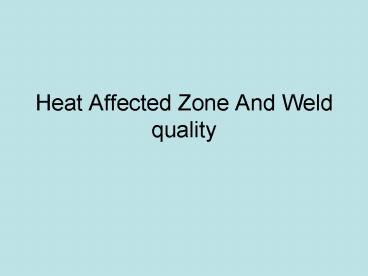Heat Affected Zone And Weld quality - PowerPoint PPT Presentation
1 / 26
Title: Heat Affected Zone And Weld quality
1
Heat Affected Zone And Weld quality
2
2D and 3D heat loss in welding
3
Heat Affected Zone
- Is within the metal itself
- Has a microstructure different from the base
metal because of elevated temperatures for a
lengthy time
Fusion zone (weld metal)
HAZ
Base metal
Molten weld metal
Melt point of base metal
Temp at which base metal microstructure is
affected
Original temp of base metal
4
- Heat applied during weld recrystallizes the
elongated grains of the base metal - Grains in the HAZ grow due to elevated
temperatures - Results in a region that is softer and has less
strength
- Inter-granular corrosion of a weld in Ferritic
stainless steel welded tube after exposure to a
caustic solution - Weld line is at center of graph
5
(No Transcript)
6
Effect of welding on workpiece
- Single pass low carbon steel weld (e.g. 0.30)
- The microstructure has six zones
- weld deposit (columnar grains)
- Fusion zone ( course grains)
- Fully austenized zone
- Transformation zone
- Austenite and ferrite zone
- Less than critical temperature zone
Schematic illustration of various regions in a
fusion weld zone and the corresponding phase
diagram for 0.30 Carbon steel
7
Properties of HAZ
- Depend on
- Rate of heat input and cooling
- The temperature to which the zone was raised
- Metallurgical properties ( grain size, grain
orientation etc) - Specific heat
- Degree of prior cold work
8
(No Transcript)
9
For metals previously subjected to cold work
- Grain growth may precede recrystallization which
can result in softening - Parts previously precipitation hardened also
soften during fusion welding - Electron beam welding / laser welding etc can be
used to minimize HAZ
10
Weld characteristics
- Reaction of gas from flame or arc play important
role in weld characteristics - Gas entrapment and chemical reaction
- If product is soluble there is no major problem
except embrittlement - Insoluble reaction can cause physical
interference to weld
11
- Degasification while cooling can lead to bubbles
being trapped - Results in poor quality
- Surface deoxidants in the filler
- Diffusion of fusion weld
- For high temperature cycle diffusion of hydrogen
into heat affected zone may cause embrittlement
12
Hydrogen Stability
- For metals with high solubility for hydrogen
(e.g. Aluminum) there is a chance of porosity - Other metals (e.g. Nickel) are not affected most
often as gases evolve out
13
Dilution and uniformity
- When filler metal is added and they differ from
the parent metal - Dilution (Weight of parent melt /total
weight of fused) X 100 - Mixing of metal
- Segmentation can also affect
- Alloy distribution
14
Weld quality
- Porosity
- Slag inclusions
- Cracks
- Residual stresses
- Incomplete fusion
- Incomplete penetration
15
Porosity
- Caused by trapped gases
- released during melting of weld area
- chemical reactions during welding
- Generally spherical or oblong
- May be concentrated in some region only
- Avoided by
- Proper selection of electrodes and fillers
- Improving welding techniques
- Preheating
- Increase heat input
- Proper cleaning
- Slowing weld speed for gases to escape
16
Slag inclusions
- Compounds, fluxes, electrode coating etc.
- If shielding gases are not effective
- Atmospheric contaminant
- In principle molten slag should float to the top
- Remedy
- Clean weld before each layer of weld is applied
- Adequate shielding gas
- Proper selection of welding electrode
17
Incomplete fusion and penetration
- Incomplete fusion can be avoided
- using good welding practice (same as for slag
inclusions) - Penetration can be avoided by
- Increasing heat input
- Lowering travel speed
- Redesign joint
18
Cracks
- Various locations and orientation
- Caused by
- Temperature variation causing thermal stress
- Variation is composition of weld zone causing
differing contractions - Embrittlement of grain boundaries by segregation
of elements - Hot cracks ( when joint is still at elevated
temp.) cold cracks (after solidification)
19
- Remedies to cracking
- Weld design to minimize stresses during cooling
- Control weld parameters
- Preheat components before welding
- Avoid rapid cooling
- Lamellar tearing
- When you weld pre-rolled plates at certain
positions - Change position of weld bead (diagram)
- Surface defects
- Electrode marks, metal sputters, carburized area
20
Residual Stresses
- Because of localized heating or cooling of joint
- Result in distortion, warping, buckling
- Stress corrosion cracking
- Reduced fatigue life
- (Figure)
- Can be avoided by preheating
- Reduced with plastic deformation and stress
relieving.
21
Residual stresses
22
Contraction
- During cooling contraction takes place this can
lead to problems such as piping and cracking - Factors affecting are
- Direction of heat loss
- Type of joint
23
Testing Welded Joints
- Destructive
- Tension test
- Bend test
- Tension-Shear test
- Fracture toughness ( Charpy V notch)
- Corrosion and creep test
- Non destructive
- Similar to those used for casting defects
24
Testing welded joints
- Destructive testing
- Tension testing specimen removed from actual
welded area - Tension shear tests- to find performance under
working conditions - Bend test ductility and strength of the weld
beads - Fracture toughness test- impacts strength
- Creep and corrosion tests because of the
composition and micro-structural variation the
welded region we might get variations or
preferential corrosion
Bend test
25
- Nondestructive testing
- ultrasound
- Magnetic particles
- X ray techniques
- Dye penetrant test
- Important for
- Functional life testing (creep, fatigue) and
design requirement testing
26
Summary
- HAZ property changes relationship to Iron
Carbon diagram grain structure etc - Weld characteristics
- Hydrogen Stability
- Weld quality
- Cracks, incomplete fusion, residual stresses
- Destructive and non destructive testing































